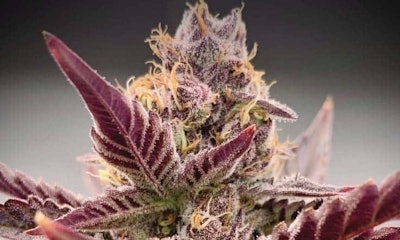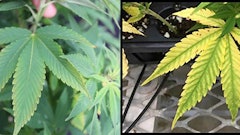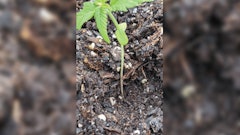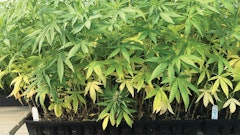

A recurring series focusing on plant cultivation by university researchers.
As plant scientists, we observe how plants grow and develop over time, and we are intrigued by variations or oddities that occur in growth. Recently, a seed-born cannabis plant in our greenhouse developed abnormal shoot growth with a flattened apical stem (Fig. 1, below). Other cannabis growers have posted images online when they too discover an odd, flat stem. We grew the plant for two months to observe the advancement of growth patterns. Over time, the shoot tip developed a mass of leaves growing out of the top (Fig. 2, below). As the plant continued to grow, the deformed portion of the stem, which measured more than 3 cm across, enlarged (Fig. 3, below) and flattened (Fig. 4, above). This phenomenon is referred to as fasciation. So, what causes this fascinating, distorted growth?
What is Fasciation?
Fasciation is defined as the development of elongated, flattened stems in plants. Fasciation occurs in a wide assortment of species and has interested plant scientists for years. One of the first scientific discussions about fasciation was reported by natural scientist Lumina C. Riddle Smyth in The Ohio Naturalist in 1903, where she lists 53 different species with confirmed fasciation symptoms. Since that time, Bulgarian and Belgian researchers report that more than 107 plant families have been observed to naturally develop symptoms. Fasciation is usually not advantageous to the plant, but in some cases, fasciation can have some highly prized ornamental attributes. One example of these include Celosia argentea cristata (crested cockscomb), which is often planted in gardens or used as cut flowers, or some cacti types where fasciation stems are grafted onto rootstocks and sold as houseplants.
What Causes Fasciation?
Fasciation is primarily caused by abiotic (non-infectious) factors such as a genetic mutation of the growing tip. As the plant meristem cells multiply, a disruption occurs that results in the production of elongated, flattened cells. These elongated cells continue to form as the plant grows into an obvious flattened stem.
Less common causes of fasciation include damage to the growing tip by insect or animal feeding, chemical applications, or physical injury such as brushing. Another mimic that results in a proliferation of growth is caused by the bacterial pathogen Rhodococcus fascians. While reported on other species such as geraniums, a preliminary literature search did not find any reports of Rhodococcus fascians infections in cannabis.
With genetically induced fasciation, usually only one branch or stem is affected. That portion of the plant can be trimmed out from flowering cannabis. While fasciation usually only involves one stem, if it appears on a mother plant, consider rogueing it out of your stock program to avoid any future occurrences. Cannabis growers have reported on online forums that when they grew out a fasciated plant, the resulting flower buds are also distorted and not well-formed. The dream of a super bud does not materialize.

Conclusions
Fasciation is an amazing growth pattern of broad and flat stems in plants that has potential in the ornamental market. Fasciation in cannabis has been reported but is infrequent. Unfortunately, flower bud growth is also negatively affected. In most cases, the cause is a genetic mutation and not an infectious disease. The affected plant part is localized in a single stem, which can be trimmed out so the remainder of the plant will grow normally.






















